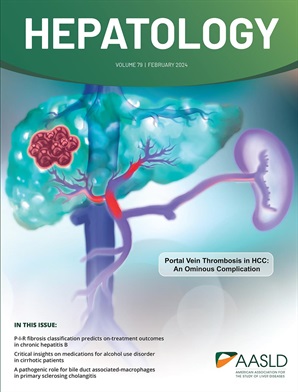激光激活纳米颗粒重组肿瘤微环境增强胆管癌中PD-1阻断和T细胞反应。
IF 15.8
1区 医学
Q1 GASTROENTEROLOGY & HEPATOLOGY
引用次数: 0
摘要
在过去的十年中,免疫疗法不断革新癌症治疗,取得了显著的进展。然而,在大多数实体肿瘤中,由于肿瘤微环境(TME)驱动的免疫抵抗,其有效性往往受到损害。在纤维化癌症中,如胆管癌(CCA),细胞外基质(ECM)和癌症相关成纤维细胞(CAFs)形成致密、坚硬的基质,阻碍免疫细胞浸润并促进免疫抑制。克服这些物理和生物障碍对于充分释放免疫治疗方法的潜力至关重要。方法结果我们开发了一种双作用策略,结合使用金装饰氧化铁纳米花(GIONFs)和PD-1免疫检查点阻断的光热疗法(PTT)。该方法在CCA临床前模型中进行了评估,以评估其对ECM重塑、CAF调节、免疫细胞激活和肿瘤生长的影响。组合策略有效地降低了ECM硬度,重新编程了CAF亚群,并增强了细胞毒性t细胞浸润。在临床前CCA模型中,治疗后的肿瘤从免疫冷状态转变为免疫热状态。这种组合增强了抗肿瘤免疫反应,降低了免疫抑制基质特征,并改善了肿瘤控制。结论纳米技术与免疫治疗相结合,对CCA等纤维化肿瘤具有重塑TME、克服免疫治疗耐药的治疗潜力。靶向ECM和免疫检查点已成为一种有前途的通用策略,以提高免疫治疗对结缔组织增生癌的疗效。本文章由计算机程序翻译,如有差异,请以英文原文为准。
Laser-activated nanoparticles rewire tumor microenvironment enhancing PD-1 blockade and T cell response in cholangiocarcinoma.
BACKGROUND AND AIMS
Immunotherapy has continued to revolutionize cancer treatment, achieving remarkable progress over the past decade. However, in most solid tumors, its effectiveness is often impaired because of immune resistance driven by the tumor microenvironment (TME). In fibrotic cancers, such as cholangiocarcinoma (CCA), the extracellular matrix (ECM) and cancer-associated fibroblasts (CAFs) form a dense, rigid stroma that hinders immune cell infiltration and promotes immunosuppression. Overcoming these physical and biological barriers is crucial for fully unleashing the potential of immunotherapeutic approaches.
APPROACH RESULTS
We developed a dual-action strategy combining photothermal therapy (PTT) using gold-decorated iron oxide nanoflowers (GIONFs) and PD-1 immune checkpoint blockade. This approach was evaluated in preclinical models of CCA to assess its impact on ECM remodeling, CAF modulation, immune cell activation, and tumor growth.The combinatorial strategy effectively reduced ECM stiffness, reprogrammed CAF subsets, and enhanced cytotoxic T-cell infiltration. In preclinical CCA models, treated tumors shift from immune-cold to immune-hot states. This combination amplifies anti-tumor immune responses, decreases immunosuppressive stromal signatures, and improves tumor control.
CONCLUSIONS
Our findings emphasize the therapeutic potential of combining nanotechnology and immunotherapy to reshape the TME and overcome immunotherapy resistance in fibrotic tumors, such as CCA. Targeting both ECM and immune checkpoints has emerged as a promising and versatile strategy to enhance the efficacy of immunotherapy against desmoplastic cancers.
求助全文
通过发布文献求助,成功后即可免费获取论文全文。
去求助
来源期刊

Hepatology
医学-胃肠肝病学
CiteScore
27.50
自引率
3.70%
发文量
609
审稿时长
1 months
期刊介绍:
HEPATOLOGY is recognized as the leading publication in the field of liver disease. It features original, peer-reviewed articles covering various aspects of liver structure, function, and disease. The journal's distinguished Editorial Board carefully selects the best articles each month, focusing on topics including immunology, chronic hepatitis, viral hepatitis, cirrhosis, genetic and metabolic liver diseases, liver cancer, and drug metabolism.
 求助内容:
求助内容: 应助结果提醒方式:
应助结果提醒方式:


